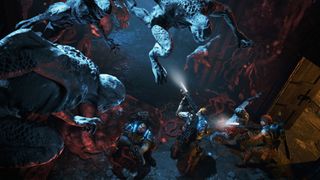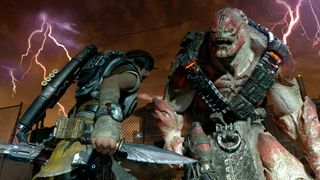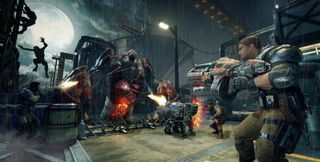Interview: In detail with Gears of War 4's Horde Mode 3.0 designer
Gears of War 4 is on the horizon, and we were lucky enough to catch up with The Coalition to discuss Horde Mode 3.0 and Multiplayer!


Gears of War 4 is coming to Xbox One and Windows 10 as a buy once, play anywhere title. Gears of War's signature PvE Horde Mode will support cross co-operative play between Xbox One and Windows 10 players, in addition to the campaign. Naturally, the PvP multiplayer modes will be platform specific, due to the competitive advantages gained from using a mouse and keyboard.
In discussion with Gears of War 4 Lead Multiplayer Designer Ryan Cleven, I learned all about Horde Mode 3.0's new class system, the Fabricator, the game's new dynamic fortification system and much more. You won't want to miss this.
Jez Corden: First of all, thank you for this opportunity! I was wondering, why did you guys decide to switch it up to a class based system for Gears of War 4? What format will that take? For example, will the classes have special abilities? Will they be locked to specific weapons and so on?
Horde Mode is about scavenging, it's about building, and we wanted to make sure players could do all of these things.
Ryan Cleven: Well we wanted to encourage the players to take on different roles to bring out more co-op gameplay. We also, at the same time, wanted to embrace what made Horde Mode. We didn't go down the Judgement route of saying 'you can only have this particular kind of weapon.'
Horde Mode is about scavenging, it's about building, and we wanted to make sure players could do all of these things. So, every class has a certain set of starting weapons or load outs, and they each have their own set of abilities on top of that to give them bonuses when doing certain things.
We have the Sniper, Scout, Soldier, Heavy and Engineer. For example, the Sniper has a bunch of abilities that pertain to getting headshots and using marksman-type weapons. So even though they start out with, you know, lower level marksman weapons, they still have the ability to run around and pick up the new EMBAR or the Longshot if they need more ammo. We wanted players to feel free to play the scavenging type game that feels like Horde. But at the same time, if there's a role they need to play because their team wants them to or because they found a class that suits their playstyle. Ideally, both of those things. We want them to be able to do so.

Ryan: It also lets us give them like, an arc. In the beginning, every class has access to a single skill card. Over time, as classes level up, they can bring up to five of cards. Every class has around 11 that they can choose from. So every time that you do a Horde run, you're going to be making a choice as to 'how do I want to build my class?' and 'how does the rest of the team want to build their classes?' It really expanded the possibilities.
Get the Windows Central Newsletter
All the latest news, reviews, and guides for Windows and Xbox diehards.
'What is the best team composition?' 'What are the best builds?' We're not sure. We're hoping players will mix and match, and experiment with different things to find the best class load outs.
From the beginning, every class will have enough skills to play in a very comfortable way, and as you play Horde, you're going to earn in-game credits, and you will be able to buy Horde Packs which contain more skills to help build up your library.
It harkens to our biggest design pillar for Gears in Horde 3.0, which is emergence. We took an approach to building classes that was more emergent than I think other more, 'strict' class designs might work.
Jez: Can you tell us a little more about the skill cards? What the abilities the cards will provide, for example? Are they similar to Halo 5's REQ system that gives weapons and other power-ups?
Ryan: You're going to get a certain number of those cards when you start. From the beginning, every class will have enough skills to play in a very comfortable way, and as you play Horde, you're going to earn in-game credits, and you will be able to buy Horde Packs which contain more skills to help build up your library.
They're a little different to REQ cards in Halo. They're permanent bonuses, and a lot of them are passive bonuses that pertain to that type of activities that that class is doing. The Scout can get a bonus that helps him seek out Power that's used to buy fortifications. The Engineer can build more cheaply and can repair more quickly. The Sniper has abilities that grant more damage or reload speed with marksman weapons. But eventually, you'll start to get more active skills. The Scout has an ability that allows him to receive health when doing damage with shotguns, and the ability to see through walls.

Ryan: So at a very basic level, they are passive ability buffs, at the mid-level, they're a little more active and at the very top level we have Strikes. Strikes are skill cards that you will have to bring in with you. You'll have to bring in a Sniper Strike, a Mortar Strike Hammer of Dawn Strike as a card and it will enable them at The Fabricator.
Jez: Speaking of the Fabricator, can you tell us a little more about it and how it works?
Ryan: The Fabricator is another one of our key examples of our new fortification that harkens back to that emergence idea. We really wanted the fortifications in Gears of War 4 to feel different than the prescribed setups we saw in Gears of War 3, while still retaining all of the great gameplay. The Fabricator is the hub of this.
So when you first start out, there's a Fabricator dropped in the middle of the map and players can run up to it, pick it up and they can take it anywhere that they want to. They can continue to move it through the entire game at any time. Whether it's the thirty-second downtime between rounds or during combat, you can pick up and move the Fabricator.
When The Fabricator is sitting somewhere, it can be used to build all the other fortifications. They are not placed on the map like in Gears of War 3. You build them out of the Fabricator. The Fabricator takes money, in the form of Power, which is dropped by enemies when you kill them. When an enemy dies, they drop power on the ground, you pick it up and bring it back to the Fabricator.

Ryan: The Fabricator is the hub of your base, effectively. If you pick up a fortification from it, such as a barrier or a turret, you can place it wherever you want. You can even pick it up again, adjust it, and find the perfect place to put that barrier to maximize the defenses. You can even stack barriers on barriers on barriers on barriers and try to grease the A.I. in whatever clever ways you can come up with. It's a game changer.
You can even stack barriers on barriers on barriers on barriers and try to grease the A.I. in whatever clever ways you can come up with. It's a game changer.
Jez: Could you create choke points with the barriers, funneling all the enemies towards a turret? Is that the sort of gameplay you're talking about?
Ryan: Yeah. Managing the choke points, using decoys to pull the creatures where you want them, using barriers to slow them down. We've added a new shock turret in addition to the classic machine gun turret. The shock turret will also slow them down and stun them. We've also added a new weapons locker which I can talk about a little bit.
It's as you described, you can set up these kill zones that are ideal for stacking the damage from both the fortifications and your team. As we talked about before, with the Sniper, it's their role to make sure that the big guys are taking lots of headshots before they get to your defenses. The big guys would otherwise be able to take out your defenses much faster.
Jez: That sounds quite epic. Speaking of the Sniper and the other classes, are they represented visually? Or do players choose their own skins as usual?
Ryan: We had gone back and forth on that. We felt that it was important for players to be able to choose what they look like. We decided to go with the ability for players to pick whatever skins they want to use and whatever class they want to play independently. What's different about them is the weapons they're carrying initially. Every class has a different weapon loadout, so when you see someone spawn you should know what class they are. There are other ways though the UI to figure out who's playing which class. However, the look of the character is up to the player as usual.

Jez: Can you tell us a little bit about the weapons locker?
Ryan: So again going back to that emergence idea. In Gears 2, it was really interesting how the most optimal way to perform was to manipulate the time between waves by picking up weapons so that they crossed the boundary of when the weapons would otherwise get cleaned up. As well as finding the best places to put the Boom Shields to create a little fort, effectively.
We're not talking about our future Horde plans, but we've definitely built it with expandability in mind.
The weapons locker provides a more formalized way of allowing players to engage with that loot. The weapons locker enables you to pick up any weapon and store it permanently. It will also be reloaded when it's inside the locker. You can then hold the weapons that you want, for as long as you want, and then deploy them on the waves that you find the most difficult. Such as a boss wave.
So imagine you've got a Mulcher or one of the new weapons like the Buzzkill, and you've expended its ammo. Typically you would have thrown that away, but instead, you can now put it back in the weapons locker, juggling two different weapons to maximize the time you have with these heavy weapons. It's one of the most powerful fortifications because it lets players use the weapons that they want to. Of course, they're still limited by how many they can store, so they have to make choices about what weapons to use and when.
Jez: Speaking of the boss waves, will we see monsters unique to Horde Mode? The system you have created sounds as though it could support a lot of longevity, similar to Halo's Warzone with extra content drops, new Elite enemies and so on.
Ryan: We're not talking about our future plans, but we've definitely built it with expandability in mind. Horde Mode will have a number of bosses. Are there unique Horde bosses? Making a boss is no simple task, we've definitely done modifications of existing enemies to adapt them to Horde Mode. Work has been done to make them specific to Horde mode, but there are no enemy types specific to Horde Mode at the moment.

Jez: Moving away from Horde Mode, what would you say are the biggest changes players can expect to see in PvP multiplayer?
Ryan: One of the biggest changes is the new close cover combat system. It allows players to lean over cover and execute with the knife. There's a whole bunch of work that we had to do to make sure that it didn't break the game while adding new moments to play.
In multiplayer, what we've tried to do is address every layer of the audience, bringing it all together inside our new skill rating system.
I think some of the new modes like Escalation for eSports, for example. In multiplayer, what we've tried to do is address every layer of the audience, bringing it all together inside our new skill rating system. Gears of War 4 has a new skill based rating system for its ranking area that isn't based on grinding. It's all based on skill. That has fed into a lot of improvements in the matchmaking to try and bring people together of similar ability.
That's really important to us because we know that historically Gears of War hasn't been the easiest multiplayer game to jump into. We want to make sure that new players have a place to play, but we also want to ensure that the high-end e-Sports players and competitive gamers also have a place to play inside the same ecosystem. We feel that Gears of War 4 is the first in the series to try to address this entire range of players in the way that we have.
Jez: That sounds like something that will appeal to me, as someone who is terrible at Gears PvP, haha.
Ryan: We've used the matchmaker in a slightly different way as well. We've provided a co-op versus playlist versus bots. I know that's almost like an oxymoron, but that means that five players can get matchmade against each other and play against A.I. inside the versus modes. We see this as a first class way to play the game. It's not a second tier feature. For players who choose to play that way, we still want to reward those who play co-op versus mode and it's a much safer place to get started in multiplayer. It's something that we hope newer players will enjoy.
A huge thank you to Ryan Cleven for joining us!
Gears of War 4's Horde Mode sounds like a massive expansion on previous versions, giving it a much-needed injection of dynamism. Between the classes, the placeable fortifications and progression layer, it feels as though Horde Mode could be the hook that keeps PvE players coming back to the game long after the campaign has ended.
Gears of War 4 is heading to Xbox One and Windows 10 as a Play Anywhere title on October 11th, 2016.

Jez Corden is a Managing Editor at Windows Central, focusing primarily on all things Xbox and gaming. Jez is known for breaking exclusive news and analysis as relates to the Microsoft ecosystem while being powered by tea. Follow on Twitter @JezCorden and listen to his XB2 Podcast, all about, you guessed it, Xbox!
